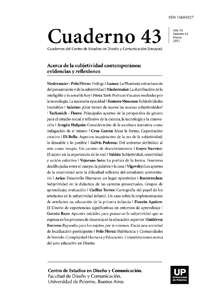Apuntes iniciales para pensar-se la subje- tividad que se expresa en los procesos de docencia en la educación superior
Abstract
The expressions of subjectivity of teachers in higher education, their pathways and implications and the possibility to start a methodical thought of subjectivity are the two basic elements that cross this article. It was decided to do a first point that is dedicated to presenting a characterization of teaching in higher education to incorporate elements to address several questions: how poses a teaching profession in a knowledge society?, What is the role of the teacher? , how do you express the subjectivity of the teacher in this kind of context?, how profession, and subjectivity talks in the university teacher? The second point raises questions about the ability to understand the subjectivity from its focus on subjectivity and dialogue with intangible products from which teaching exercise is fed: this discussion is approached from two strains: simulation as subjection device to identify that is an important and symbolic type of management that impact the society of producers. The second strain approaches the ambiguity that arises between the need for certainty and the emergency to arise as a human being with claims of autonomy, dual cases, ethereal and present understandings that represent on one hand, the assumed urgency as subject involved and on the other hand, the exploration of a topic that although not new, if has been constituted in a permanent question in time. Thus, these initial notes open a wedge alternative for self- thinking subjectivity in contemporary and specifically on the stage of “doing teaching”.
References
Bandura, A. y. (1974 ). Aprendizaje social y desarrollo de la personalidad. Madrid: Alianza.
Baudrillard, J. (1978). Cultura y simulacro. Barcelona: Kairos.
(1974). La sociedad de consumo. Sus mitos, sus estructuras. Barcelona: Plaza y Janes.
Bauman, Z. (2001). En busca de la política. Buenos Aires: Fondo de Cultura Económica.
Bentham, J. (1989). El Panóptico. Madrid: La Piqueta.
Berger, P. y. (1967). La construcción social de la realidad. Buenos Aires: Amorrortu.
Bruno, L. (2011). La esperanza de Pandora. Ensayos sobre la realidad de los estudios de la ciencia. Barcelona: Gedisa. Recensión.
Castell, M. (2006). La Sociedad Red. Madrid: Alianza Editorial.
Deleuze, G. (1990). Postcritum de las sociedades de control. (Traduccion, Ed.) Autre Journal (1), 20-35.
Foucault, M. (2002). La hermenéutica del sujeto. Mexico: Fondo de Cultura Económica.
Garzon, O. (2011). Protocolos Seminario doctoral “Educación, subjetividad y estéticas: una mirada investigativa”. Protocolo, Cali.
Ginsburg, C. (1999). Mitos, Emblemas e Indicios: morfología e historia. Barcelona: Gedisa.
Goffman, E. (1974). Análisis estructural. Un ensayo sobre la organización de la experiencia. Harper Colophon. Nueva York: Harper Colophon.
Gonzáles, J. D. (2006). Ciudad, conflicto y generaciones: una aproximación al génesis de la juventud en la Ciudad de Cali. Fundación Ciudad Abierta.
Latour, B. (2001). La esperanza de Pandora. Ensayos sobre la realidad de los estudios de la ciencia. Barcelona: Gedisa.
Lazzarato, M. (2003). Lucha, acontecimiento, media. Roma.
M, C. (2006). La Sociedad Red. Madrid: Alianza Editorial.
Mead, G. (1972). Espíritu, persona y sociedad. Buenos Aires: Paidós.
Najmanovich, D. (2008). Mirar con nuevos ojos. Nuevos paradigmas en la ciencia y el pensamiento complejo. Buenos Aires: Gedisa.
Perez, A. I. (2000). La cultura escolar en la sociedad neoliberal. Madrid: Morata.
Russi, I. (2000). Formación de profesores de la Educacion Superior programa Nacional Icfes. Bogota: Icfes.
S, G. (2006). Teorías sin disciplina. La translocalización discursiva de “Latinoamérica” en tiempos de la globalización. Teorías en debate. Bogotá.
Los autores/as que publiquen en esta revista ceden los derechos de autor y de publicación a "Cuadernos del Centro de Estudios de Diseño y Comunicación", Aceptando el registro de su trabajo bajo una licencia de atribución de Creative Commons, que permite a terceros utilizar lo publicado siempre que de el crédito pertinente a los autores y a esta revista.


